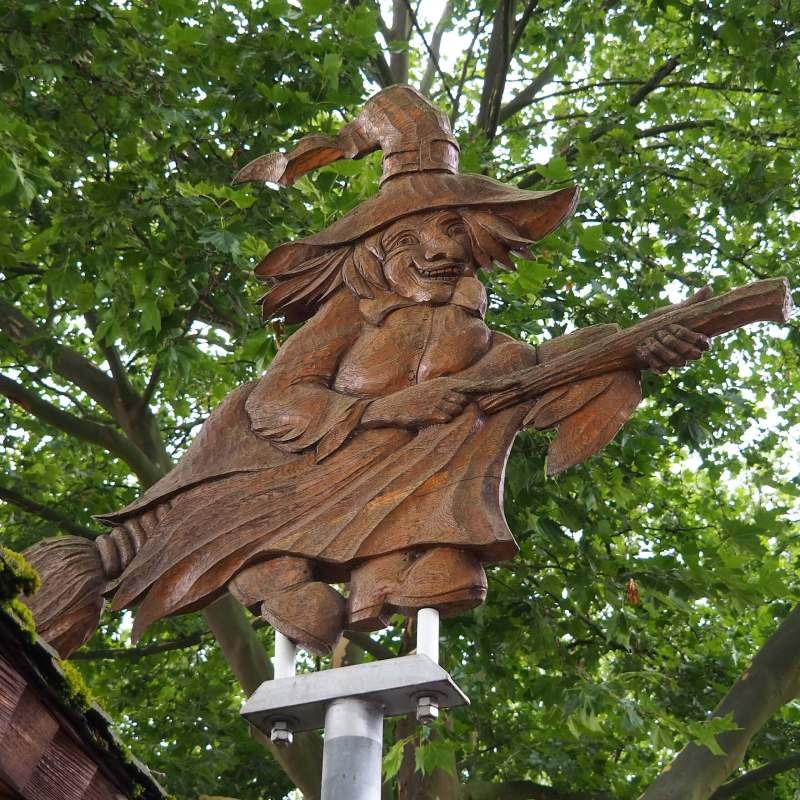Eerie Hike in Harz, Germany

The inscription on the wooden refuge, where I paused to savor my Käsebrötchen, made a bold promise. It declared, “Wanderer,” or so Google Translate indicated, “I protect you from the elements, a guardian against ill intentions.” An overstatement? Perhaps, but such assurance feels necessary when enjoying cheese rolls in these haunting surroundings.
Originally built to provide respite for medieval donkey drivers transporting goods from Osterode to the mines in northern Germany’s Harz Mountains, this newer structure now fulfills the same purpose. It serves as a resting spot for hikers like me, journeying along the Harzer Hexen-Stieg (Harz Witches’ Trail).
It’s challenging to resist a trail with such a captivating name, right? This name has deep roots in local folklore and happens to align with the current trend of “witch lit” gaining popularity. In 2023, notable works like Emilia Hart’s ‘Weyward’ and Margaret Meyer’s ‘The Witching Tide’ have emerged, while a movement among older women is reclaiming the term “crone.” Plus, it felt like the perfect choice for an autumn escapade. The well-kept 60-mile path from Osterode to Thale, typically completed in four to six days, promised dry paths, an atmospheric mist, cozy inns, hearty pork dinners each night, and a plethora of haunting tales. What awaited me was truly captivating and eerie in ways I hadn’t anticipated.
I set off from Osterode around noon, surrounded by the bustling market square alive with the sound of church bells and an array of vendors – buskers, butchers, florists, and fishmongers. It was clear that the locals had wholeheartedly embraced the witchy theme, with pointy-hatted figures adorning many gardens and window ledges.
However, once I delved into the countryside, the narrative shifted toward the area’s robust industrial legacy. The Upper Harz stands as one of Europe’s oldest and most pivotal mining regions, having engaged in silver, lead, and copper mining since the early 13th century, earning its distinction as a UNESCO World Heritage site. The mining operations harnessed an impressive infrastructure, including 107 ponds, 195 miles of ditches, and 19 miles of waterways. The witches’ trail traces some of these water features, navigating ancient dams, streams, and pathways lined with berry bushes.
One of the remnants I cherished from this industrial past stood in Altenau, where I lodged at the Landhaus am Kunstberg guesthouse on my first night. Here, one of the ponds has been transformed into the Waldschwimmbad Okerteich, an expansive woodland-fringed natural swimming pool open year-round, free of charge—albeit with quite chilly waters. A bracing dip before breakfast, with only the company of wagtails witnessing my occasional yelps, readied me for the day’s hike ahead.
I also savored my time in Altenau. This town’s journey into tourism traces back to the late 19th century, leaving behind a heritage of delightful villas. Along the main street, you’ll find a bakery, brewery, a model train store, and shops featuring an array of witch-themed items. Here, the trail joins the Goetheweg, retracing the steps of the famed German writer Johann Wolfgang von Goethe. It was along this trail that Goethe first ascended the nearby 1,141-meter Brocken mountain in December 1777. Across multiple visits, this landscape became a wellspring of inspiration for his literary masterpieces, notably “Faust,” where the Harz Mountains’ highest peak serves as the domain for reveling witches.
The Brocken mountain maintains an uncanny ambiance for several reasons. It’s cloaked in mist for about 300 days a year and held a secretive air for a prolonged period. The division between East and West Germany cut through this region, and after the Berlin Wall’s erection, East German authorities sealed off the Brocken’s summit plateau, using its potent communication towers for espionage in Western Europe. During my stroll, I encountered remnants of the concrete barrier and stumbled upon a stone memorial bearing an inscription that commemorated the December 1989 moment when Germans regained access to their beloved mountain, boldly declaring, “Brocken Free Again!”
These days, the most disconcerting feature of the Brocken and the western Harz region is found within its forests. I was taken aback by the extensive devastation caused by the bark beetle, leaving an eerie mark on the scenery. In some areas, it resembles a scene from Halloween, where hillsides are adorned with rows of skeletal spruce trees. Elsewhere, barren stumps intersperse with groundsel and willowherb. The impact of the climate crisis has rendered non-native spruce trees, planted in uniform patterns for centuries, increasingly susceptible to attacks by these beetles.
Perched atop the Trudenstein outcrop, named for its likeness to a Drude, a witch-like figure associated with nightmares, I encountered a vacationer from Hamburg. Together, we surveyed the afflicted landscape. He sighed with a touch of nostalgia and remarked, “The Harz was once so incredibly beautiful.”


